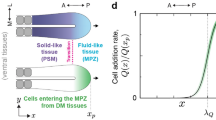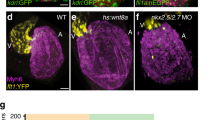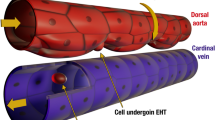Abstract
The pattern of blood flow in the developing heart has long been proposed to play a significant role in cardiac morphogenesis. In response to flow-induced forces, cultured cardiac endothelial cells rearrange their cytoskeletal structure and change their gene expression profiles1,2. To link such in vitro data to the intact heart, we performed quantitative in vivo analyses of intracardiac flow forces in zebrafish embryos. Using in vivo imaging, here we show the presence of high-shear, vortical flow at two key stages in the developing heart, and predict flow-induced forces much greater than might have been expected for micro-scale structures at low Reynolds numbers. To test the relevance of these shear forces in vivo, flow was occluded at either the cardiac inflow or outflow tracts, resulting in hearts with an abnormal third chamber, diminished looping and impaired valve formation. The similarity of these defects to those observed in some congenital heart diseases argues for the importance of intracardiac haemodynamics as a key epigenetic factor in embryonic cardiogenesis.
This is a preview of subscription content, access via your institution
Access options
Subscribe to this journal
Receive 51 print issues and online access
$199.00 per year
only $3.90 per issue
Buy this article
- Purchase on Springer Link
- Instant access to full article PDF
Prices may be subject to local taxes which are calculated during checkout




Similar content being viewed by others
References
Topper, J. N. & Gimbrone, M. A. Blood flow and vascular gene expression: fluid shear stress as a modulator of endothelial phenotype. Molec. Med. Today 5, 40–46 (1999)
Davies, P. F. Flow-mediated endothelial mechanotransduction. Physiol. Rev. 75, 519–560 (1995)
Nerem, R. M., Harrison, D. G., Taylor, W. R. & Alexander, R. W. Hemodynamics and vascular endothelial biology. J. Cardiovasc. Pharmacol. 21, S6–S10 (1993)
Takahashi, M., Ishida, T., Traub, O., Corson, M. A. & Berk, B. C. Mechanotransduction in endothelial cells: Temporal signaling events in response to shear stress. J. Vasc. Res. 34, 212–219 (1997)
Taber, L. A. Mechanical aspects of cardiac development. Prog. Biophys. Mol. Biol. 69, 237–255 (1998)
Chen, J. N. & Fishman, M. C. Genetics of heart development. Trends Genet. 16, 383–388 (2000)
Srivastava, D. & Olson, E. N. A genetic blueprint for cardiac development. Nature 407, 221–226 (2000)
Helmlinger, G., Geiger, R. V., Schreck, S. & Nerem, R. M. Effects of pulsatile flow on cultured vascular endothelial-cell morphology. J. Biomech. Eng. Trans. ASME 113, 123–131 (1991)
Olesen, S. P., Clapham, D. E. & Davies, P. F. Hemodynamic shear-stress activates a K+ current in vascular endothelial cells. Nature 331, 168–170 (1988)
Stainier, D. Y. R. & Fishman, M. C. The zebrafish as a model system to study cardiovascular development. Trends Cardiovasc. Med. 4, 207–212 (1994)
Walsh, E. C. & Stainier, D. Y. R. UDP-glucose dehydrogenase required for cardiac valve formation in zebrafish. Science 293, 1670–1673 (2001)
Hou, P-C. L. & Burggren, W. W. Cardiac output and peripheral resistance during larval development in the anuran amphibian Xenopus laevis. Am. J. Physiol. Regul. Integr. Compar. Physiol. 38, R1126–R1132 (1995)
Mankad, R. et al. Regional myocardial strain before and after mitral valve repair for severe mitral regurgitation. J. Cardiovasc. Magn. Res. 3, 257–266 (2001)
Willert, C. E. & Gharib, M. Digital particle image velocimetry. Exp. Fluids 10, 181–193 (1991)
Pelster, B. & Burggren, W. W. Disruption of hemoglobin oxygen transport does not impact oxygen-dependent physiological processes in developing embryos of zebra fish (Danio rerio). Circ. Res. 79, 358–362 (1996)
Long, Q. M. et al. GATA-1 expression pattern can be recapitulated in living transgenic zebrafish using GFP reporter gene. Development 124, 4105–4111 (1997)
Davies, P. F., Remuzzi, A., Gordon, E. J., Dewey, C. F. & Gimbrone, M. A. Turbulent fluid shear-stress induces vascular endothelial-cell turnover in vitro. Proc. Natl Acad. Sci. USA 83, 2114–2117 (1986)
Manasek, F. J. & Monroe, R. G. Early cardiac morphogenesis is independent of function. Dev. Biol. 27, 584–588 (1972)
Hogers, B., DeRuiter, M. C., GittenbergerdeGroot, A. C. & Poelmam, R. E. Unilateral vitelline vein ligation alters intracardiac blood flow patterns and morphogenesis in the chick embryo. Circ. Res. 80, 473–481 (1997)
Icardo, J. M. Developmental biology of the vertebrate heart. J. Exp. Zool. 275, 144–161 (1996)
Liao, E. C. et al. Non-cell autonomous requirement for the bloodless gene in primitive hematopoiesis of zebrafish. Development 129, 649–659 (2002)
Stainier, D. Y. R. et al. Mutations affecting the formation and function of the cardiovascular system in the zebrafish embryo. Development 123, 285–292 (1996)
Sehnert, A. J. et al. Cardiac troponin T is essential in sarcomere assembly and cardiac contractility. Nature Genet. 31, 106–110 (2002)
Meinhart, C. D., Wereley, S. T. & Santiago, J. G. PIV measurements of a microchannel flow. Exp. Fluids 27, 414–419 (1999)
O'Brien, S. P. M., Wheeler, T. & Barker, D. J. P. Fetal Programming Influences on Development and Disease in Later Life (RCOG, London, 1999)
Di Stefano, I., Koopmans, D. R. & Langille, B. L. Modulation of arterial growth of the rabbit carotid artery associated with experimental elevation of blood flow. J. Vasc. Res. 35, 1–7 (1998)
Langille, B. L. Flow-dependent Regulation of Vascular Function (eds Bevan, J. A., Kaley, G. & Rubanyi, G.) 277–299 (Oxford Press, New York, 1995)
Kimmel, C. B., Ballard, W. W., Kimmel, S. R., Ullmann, B. & Schilling, T. F. Stages of embryonic-development of the zebrafish. Dev. Dyn. 203, 253–310 (1995)
Westerfield, M. The Zebrafish Book (Univ. Oregon Press, Eugene, 1995)
Acknowledgements
We thank S. Lin for the stable transgenic gata1::GFP zebrafish strain, E. Walsh, E. Ober, B. Jungblut and D.Y.R. Stainier for the transgenic tie2::GFP strain and comments on the manuscript and M. Bak and Y. Gong for discussions. This work was supported by the American Heart Association (J.R.H.) and the Human Frontier Science Program (R.W.K.), the NIH (S.E.F.), the Beckman Institute at Caltech and the Powell Foundation. J.R.H. worked on flow pattern analysis and calculations. R.W.K. worked on imaging and embryonic manipulation.
Author information
Authors and Affiliations
Corresponding authors
Ethics declarations
Competing interests
The authors declare that they have no competing financial interests.
Supplementary information
41586_2003_BFnature01282_MOESM2_ESM.mov
Supplementary Movie 2: Dynamics of heart valves in 4.5dpf old homozygous tie2::GFP transgenic zebrafish embryos. (MOV 746 kb)
41586_2003_BFnature01282_MOESM9_ESM.mov
Supplementary Movie 9: Cardiac dynamics in homozygous tie2::GFP transgenic zebrafish embryos at 4.5dpf after continuously blocking blood influx into the heart. (MOV 724 kb)
41586_2003_BFnature01282_MOESM10_ESM.mov
Supplementary Movie 10: Cardiac dynamics in homozygous tie2::GFP transgenic zebrafish embryos at 4.5dpf after continuously blocking blood efflux out of the heart. (MOV 643 kb)
Rights and permissions
About this article
Cite this article
Hove, J., Köster, R., Forouhar, A. et al. Intracardiac fluid forces are an essential epigenetic factor for embryonic cardiogenesis. Nature 421, 172–177 (2003). https://doi.org/10.1038/nature01282
Received:
Accepted:
Issue Date:
DOI: https://doi.org/10.1038/nature01282
This article is cited by
-
Surmounting photon limits and motion artifacts for biological dynamics imaging via dual-perspective self-supervised learning
PhotoniX (2024)
-
Multiple pkd and piezo gene family members are required for atrioventricular valve formation
Nature Communications (2023)
-
Standardisation and future of preclinical echocardiography
Mammalian Genome (2023)
-
Associations between congenital heart disease and air pollutants at different gestational weeks: a time-series analysis
Environmental Geochemistry and Health (2023)
-
Predisposition to atrioventricular septal defects may be caused by SOX7 variants that impair interaction with GATA4
Molecular Genetics and Genomics (2022)
Comments
By submitting a comment you agree to abide by our Terms and Community Guidelines. If you find something abusive or that does not comply with our terms or guidelines please flag it as inappropriate.



